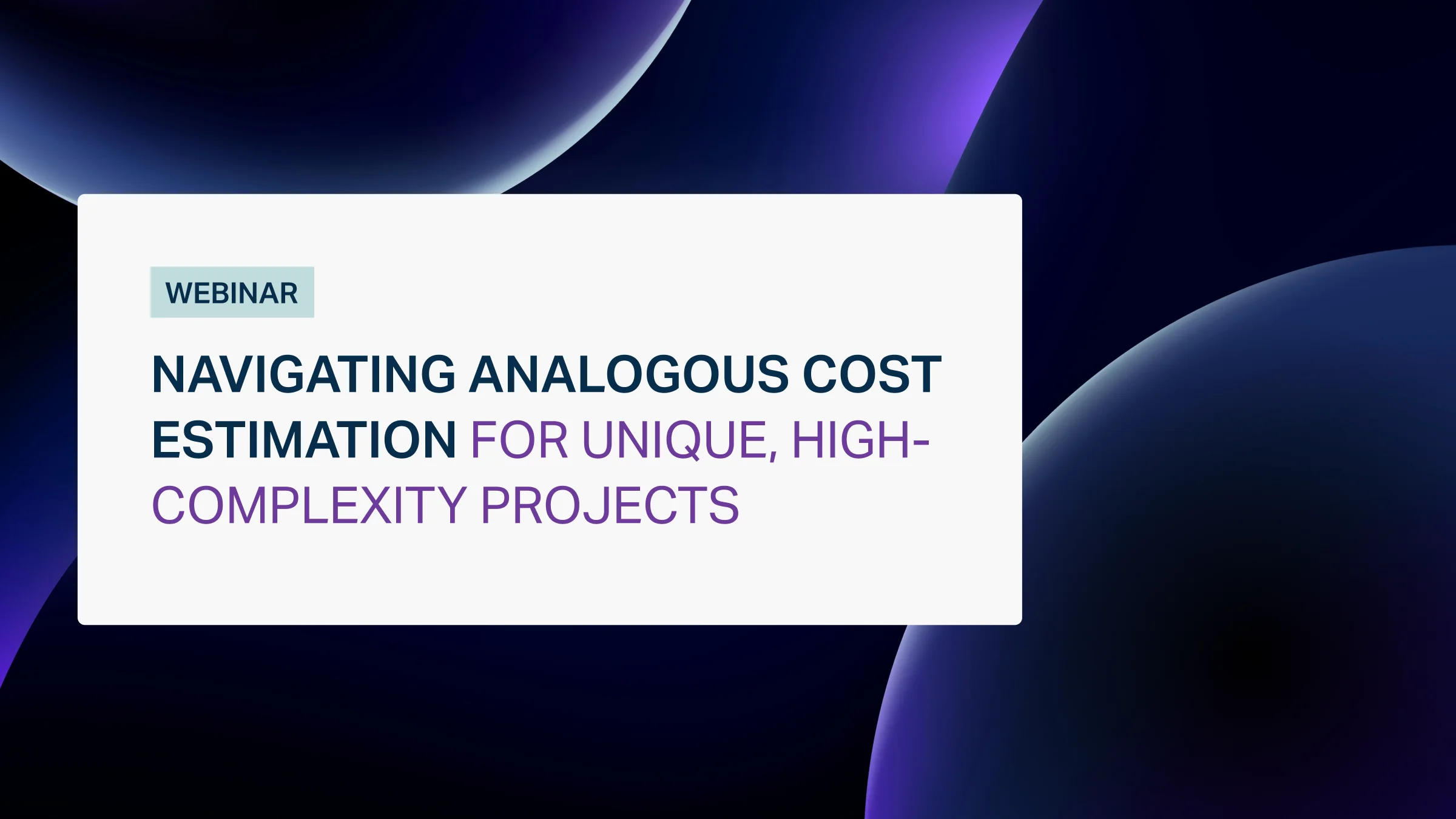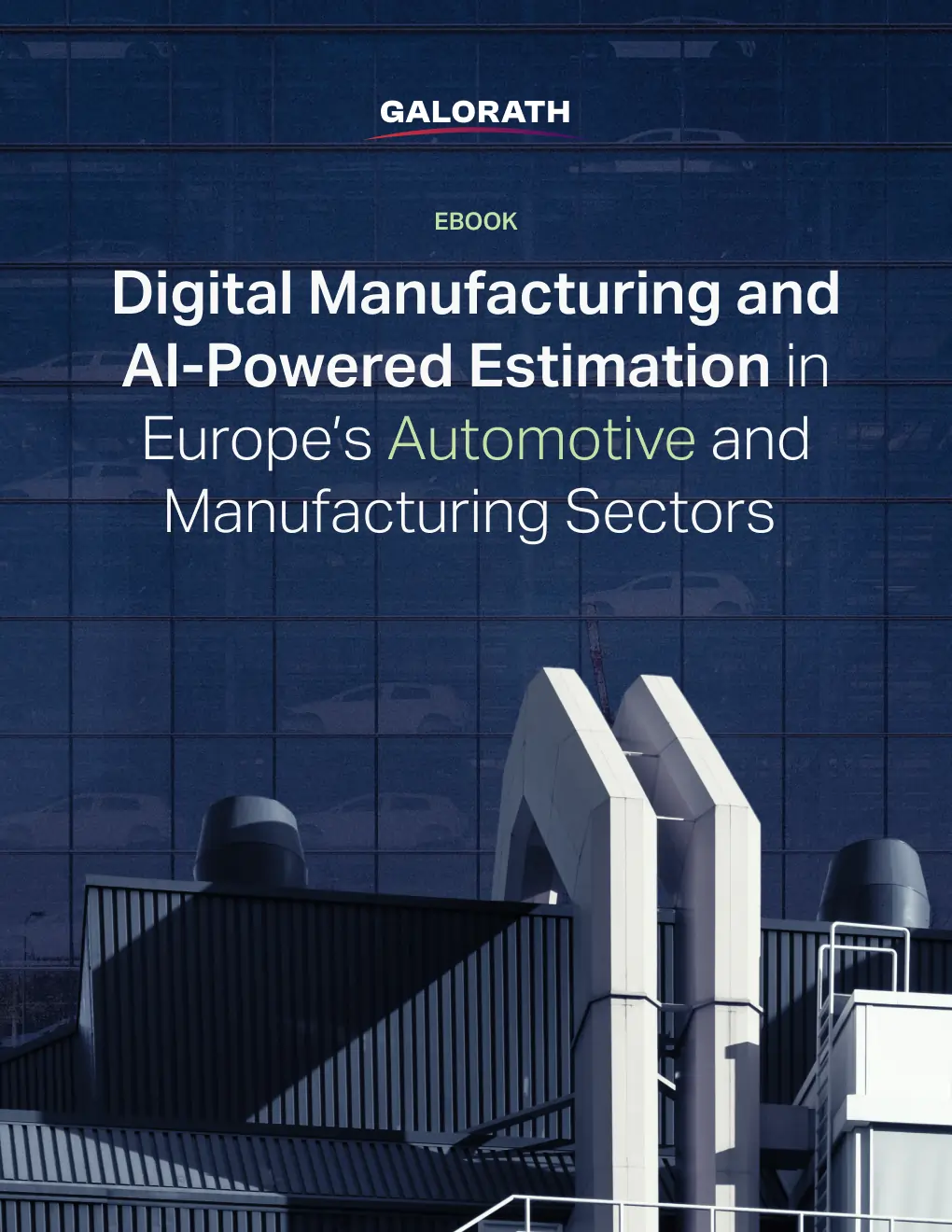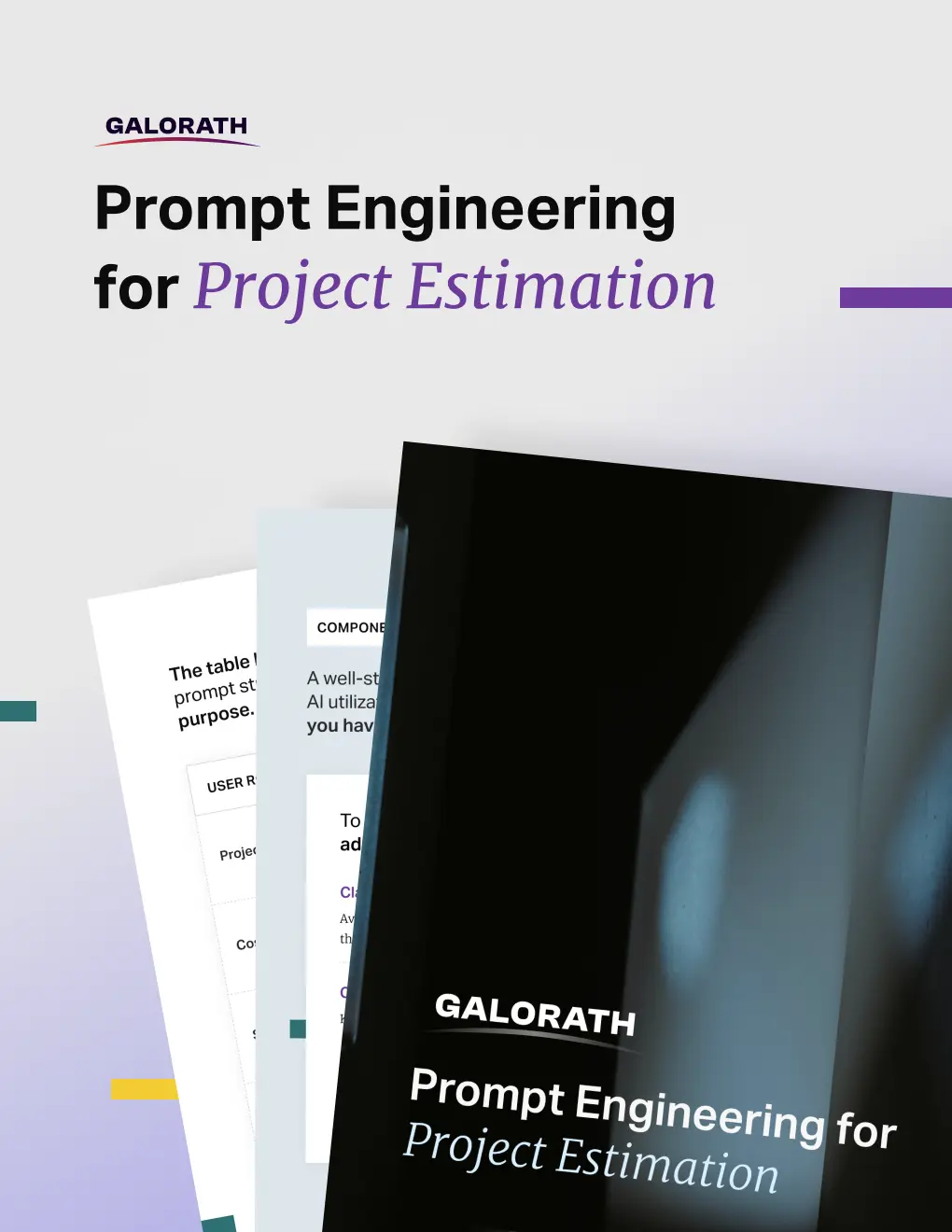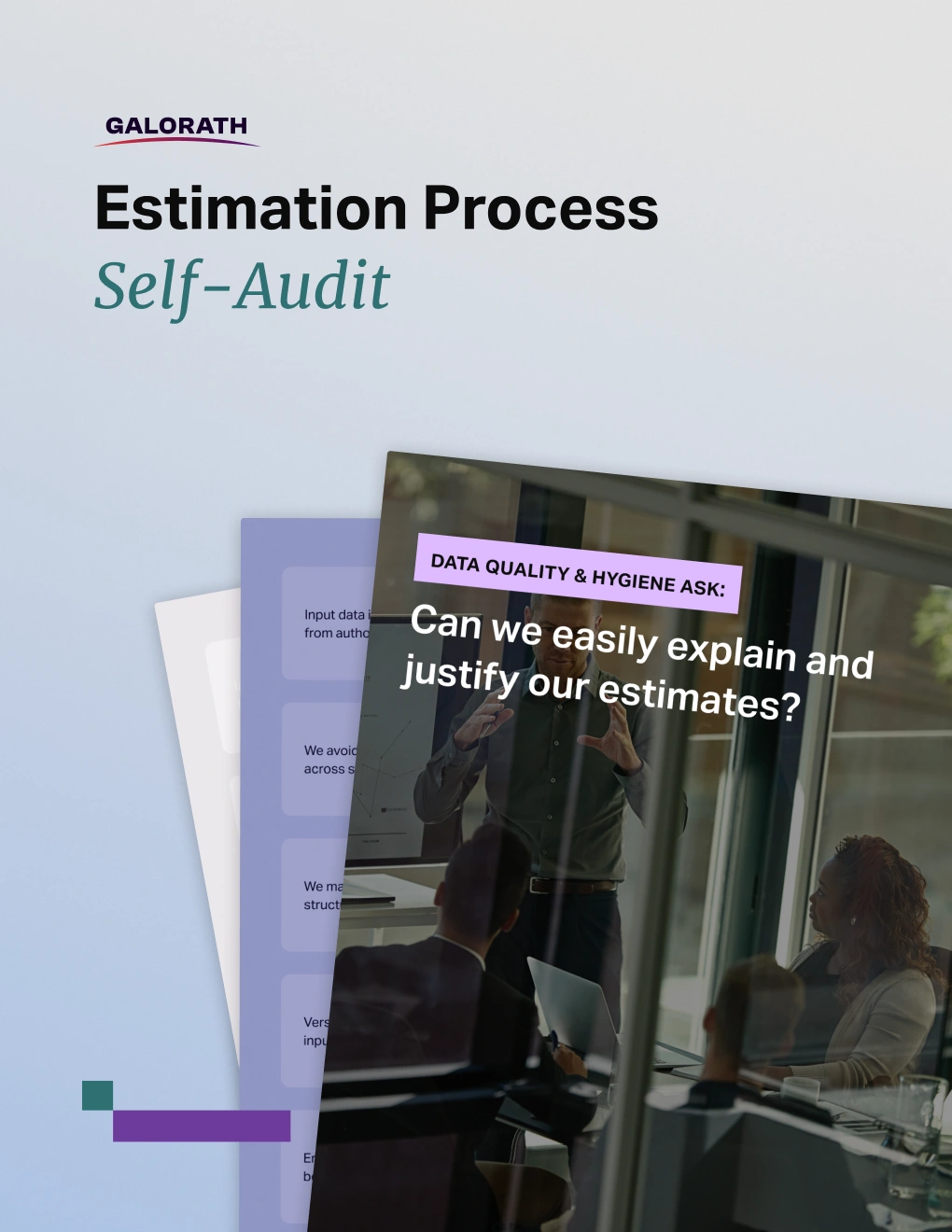Mastering Cost Risk with the CRED Model: A New Approach to Managing Uncertainty
A Rough Order of Magnitude (ROM) estimate is an early, high-uncertainty projection of cost and duration, typically developed during the initiation phase of a project. It supports go/no-go decisions, feasibility analysis, and project prioritization when detailed data is scarce. With an accuracy range of −25% to +75%, ROM estimates reflect the uncertainty inherent in early planning and are intended to guide high-level funding and strategic direction rather than provide execution-ready figures.
ROM estimates precede the development of formal baselines, scope, schedule, and cost – and are gradually refined as more information becomes available. Various industries use tailored ROM techniques: from story points and T-shirt sizing in software to square-foot pricing in construction or NRE/tooling in manufacturing. Estimation methods like analogous, parametric, and three-point (PERT) analysis offer flexibility to balance speed and precision, depending on context and data availability.
Creating a ROM involves defining scope, selecting techniques, gathering historical inputs or cost estimating relationships (CERs), and applying uncertainty modeling through confidence levels (P50, P80). As the project matures, ROM estimates evolve into more definitive cost baselines aligned with Earned Value Management (EVM) systems.
While multiple tools support ROM generation, SEER by Galorath stands out for its ability to produce defensible ROM estimates early in the lifecycle by leveraging domain-specific models, calibrated historical data, and parametric logic.
Struggling to Produce Trustworthy ROM Estimates?
SEER by Galorath provides high-confidence ROM estimates even with limited inputs.
Support bids, feasibility studies, and early planning with clarity.
What Is a ROM Estimate?
A Rough Order of Magnitude (ROM) estimate is an early, high-level cost and duration estimate used for screening, early funding, and portfolio sizing. As E. D. Canedo note in “Methods for Estimating Agile Software Projects“ paper, ROM estimates are typically used during the initial phases of a project to provide a rough budgetary projection based on limited data.
ROM provides a broad range rather than a single figure, acknowledging its directional nature and the high uncertainty at the project’s outset.
According to A. Banerjee, a ROM estimate is highly flexible, encompassing a large range of uncertainty because it relies on minimal data and expert judgment, which makes it exactly a rough estimate, as the name suggests.
How accurate is Rough Order of Magnitude?
A ROM estimate typically carries an accuracy range of −25% to +75%, depending on the available data and project complexity. According to J. Harris and R. Prescott, ROM estimates are often provided with a wide range of accuracy, typically due to the initial uncertainty and limited data available.
The accuracy of the ROM can vary due to factors like data maturity, domain knowledge, and the complexity of the project.
To express confidence in the ROM, it’s common to use P50 (50% confidence level) or P80 (80% confidence level) to show how likely the estimate is to fall within the specified range. As more details become available or as the project evolves, it’s important to re-estimate to improve accuracy.
As L. Dysert points out, ROM estimates should be revisited as project details unfold, improving their precision and reducing uncertainty.
ROM vs Budgetary vs Definitive Estimate
| Type of Estimate | Inputs | Cycle Time to Produce | Governance | Variance |
| ROM Estimate | Limited data, historical | Fast | Low, for screening | High (−25% to +75%) |
| Budgetary Estimate | More detailed data, initial assumptions | Moderate | Medium, for early decision-making | Moderate |
| Definitive Estimate | Detailed data, project specifics | Time-consuming | High, for final approval | Low (−5% to +10%) |
ROM is a precursor to budgetary and definitive estimates. ROM provides a rough idea, budgetary estimates offer more detail, and definitive estimates are highly precise, used to lock in final project costs.
Where ROM Fits in the Project Baseline?
The progression of estimates looks like this:
ROM → planning elaboration → project baseline (scope/schedule/cost baselines) → performance measurement (EVM).
ROM sets the initial range, which is refined during planning elaboration. As the project moves forward, detailed scope, schedule, and cost baselines are developed, followed by performance measurement through Earned Value Management (EVM).
ROM Use Cases by Industry
Different industries use ROM estimates based on their unique factors and metrics:
- Software: Uses story points or KLOC (thousands of lines of code) to estimate project size and complexity.
- Hardware/Manufacturing: Focuses on $ per square foot or NRE (non-recurring engineering) and tooling costs to estimate hardware or manufacturing projects.
- Construction: Relies on metrics like $/square foot and location/site factors to account for variability in construction costs.
- Aerospace/Defense: Factors like learning curves, NRE/tooling costs, and site/location factors play a significant role in estimating costs.
How to Create a ROM Estimate?
Creating a ROM estimate involves a 5-step workflow that helps define the project’s scope, identify the right estimation techniques, and account for uncertainty.
1) Define ROM-Level Scope & Assumptions
The first step is to clearly define the ROM-level scope and outline the key assumptions that will shape the estimate. This includes capturing capability goals, inclusions, exclusions, and constraints.
Establishing acceptance criteria and a high-level Work Breakdown Structure (WBS) is essential to set clear scope boundaries and prevent scope creep. Documenting these assumptions ensures clarity and provides a reference for future refinements.
2) Choose an Estimation Technique
Next, choose the most suitable estimation technique based on the available data and project context. Common techniques include:
- Analogous Estimating: Quick and based on similar past projects. Fast but less accurate.
- Parametric Estimating (CERs): Uses cost estimating relationships (CERs) for more precise estimates based on known variables. Accurate but requires a good understanding of past projects.
- Three-Point Estimating/PERT: Applies minimum, most likely, and maximum values to generate an average estimate, useful for uncertain scenarios.
- T-Shirt Sizing: Quick and high-level, used when there’s little data available. Fast but not highly accurate.
Each method has its trade-offs: speed vs accuracy. Choose the method that balances these factors according to the project’s needs.
3) Gather Inputs (Historicals, Benchmarks, CERs)
Collect relevant inputs, including historical data, industry benchmarks, and cost estimating relationships (CERs). This data provides the foundation for a more informed estimate. Calibration and normalization are key to ensuring the data fits the specific project context.
SEER provides validated knowledge bases that can further enhance the accuracy of your estimates by offering pre-calibrated data for similar projects.
4) Quantify Uncertainty & Risks
Once the data is collected, quantify the uncertainty in the estimate by defining min/most-likely/max ranges for each cost and duration component. You can optionally apply PERT analysis or run light Monte Carlo simulations to model and understand the variability and risk in the estimate.
Outcomes should be expressed as P50 (50% confidence level) or P80 (80% confidence level) to communicate the probability of the estimate falling within the specified range.
5) Document & Publish the Range
Finally, document and publish the ROM range by presenting the low/likely/high values, along with the drivers and assumptions that influenced the estimate. Maintain a versioned ROM assumptions register to track changes over time.
It’s important to define a refresh cadence to update the ROM as new data becomes available or as the project progresses.
Rough Order of Magnitude (ROM) Format
While the Rough Order of Magnitude is by nature an approximate estimate, its usefulness depends on how clearly it is communicated. A structured and transparent format allows stakeholders to interpret not just the numbers, but the assumptions, context, and level of uncertainty behind them. Standardizing the presentation of a ROM also ensures traceability as the estimate evolves into a budgetary or definitive cost baseline later in the project lifecycle.
A well-structured ROM format typically includes five key sections: the summary header, contextual scope, cost range presentation, key drivers and assumptions, and governance notes. Each of these components plays a role in transforming what could otherwise be a vague approximation into a credible, defensible early estimate.
1. ROM Summary Header
Every ROM estimate should begin with a summary header that clearly identifies the estimate type and its confidence range. This header includes essential metadata, such as the estimate title, version, author or preparer, date of creation, and declared accuracy range (for example, −25% to +75%). Stating these parameters explicitly helps decision-makers interpret the estimate as what it is: an early-stage planning figure intended for feasibility and prioritization, not for contracting or baseline control.
2. High-Level Scope and Context
The next section defines what the estimate represents and, equally important, what it does not. It should briefly describe the project scope, intended deliverables, and the current level of design or definition (e.g., “concept drawings only,” “10% design maturity”). Explicitly noting inclusions and exclusions—such as whether site preparation, overhead, or sustainment costs are covered—helps prevent later misinterpretation.
Contextual notes should also explain the data sources used (historical analogies, expert judgment, or benchmark rates) and the primary purpose of the ROM—whether it supports a go/no-go decision, early funding request, or concept validation.
3. Base Estimate and Range Presentation
The heart of the ROM is its base estimate and associated range. The base figure represents the central or most likely value derived from available data and methods, while the upper and lower bounds communicate uncertainty. This range should always be stated numerically and as a percentage variance—for example, Base Estimate: $4.0 million (−25% / +75%) = Range: $3.0–$7.0 million.
To improve interpretability, many organizations include confidence levels such as P50 or P80, indicating the probability that actual outcomes will fall within the stated limits. Including this statistical framing reinforces transparency and helps executives align expectations with risk appetite.
4. Key Assumptions and Cost Drivers
Because a ROM estimate is built on limited data, documenting assumptions is as important as the numeric result. This section identifies the major cost drivers—such as unit size, material rates, productivity factors, or complexity indices—and records the assumptions underpinning them. For example: “Assumes 20% reuse of existing code,” or “Labour rate of $120/hour based on prior program averages.”
Recording these assumptions creates an audit trail for future refinements. It also allows other estimators, program managers, or oversight teams to understand how the ROM was constructed and what conditions might change its validity.
5. Governance, Notes, and Revision Plan
Finally, each ROM format should include governance information and a plan for revision. This includes who approved or reviewed the estimate (e.g., PMO, finance, or engineering lead), what stage gate or milestone it supports, and when it will next be updated. Documenting review paths and version histories improves accountability and traceability—essential qualities for complex, regulated environments such as defense, aerospace, or infrastructure.
A note on transparency: while it may be tempting to present a single “best guess” number, doing so erodes the integrity of the ROM. The strength of a ROM lies in its range-based communication—acknowledging uncertainty rather than concealing it. A well-formatted ROM provides clarity, context, and credibility even in the absence of detailed data.
By standardizing the ROM format and maintaining consistency across programs, organizations not only improve internal communication but also establish a foundation for progressive estimating maturity. As projects advance, this same structure can evolve seamlessly into budgetary and definitive estimates, ensuring that the early assumptions remain visible and testable throughout the project lifecycle.
ROM Estimation Techniques
Different ROM estimation techniques serve various purposes in early project planning. Below is a playbook for each method, including when to use it, its limitations, and quick examples.
Analogous (Top-Down)
Analogous estimating is a high-level method where you base the ROM estimate on similar past projects. It’s often used when there is limited data or when speed is crucial.
Best for projects with a similar scope and technical complexity to previous ones. Ideal when you’re in the early stages of a project and need a quick estimate.
A key risk is the false analogy, when the previous project doesn’t align well with the current one, leading to inaccurate estimates.
If a previous project building a similar software application took 3 months and $100,000, and the current project is expected to be about 20% larger, you can estimate the new project at 3.6 months and $120,000.
Parametric Estimating & CERs
Parametric estimating uses unit rates (e.g., $ per square foot, hours per story point, KLOC) to calculate costs or durations based on specific metrics. Cost Estimating Relationships (CERs) are derived from historical data to provide a more accurate estimate.
Ideal for projects with well-understood unit rates or measurable variables. Best for repeatable tasks or projects with established performance data.
For a construction project, if the cost is $150 per square foot and the building is 5,000 square feet, the estimate would be:
$150 x 5,000 = $750,000.
In software development, if the average KLOC (thousands of lines of code) cost is $10,000 per KLOC, and you estimate 50 KLOC, the cost estimate would be:
$10,000 x 50 = $500,000.
This approach can be enhanced by using advanced cost modeling software like SEER, which applies calibrated Cost Estimating Relationships (CERs) derived from historical data to deliver more accurate and reliable estimates.
Three-Point / PERT
The Three-Point Estimate method, often used with PERT analysis, calculates an average of three values: Optimistic (O), Most Likely (M), and Pessimistic (P). The formula for calculating a weighted average is (O + 4M + P) / 6, which places more weight on the most likely estimate.
This method is ideal when there’s uncertainty or when estimating duration and costs with uncertain variables.
Let’s assume a project task’s duration is estimated with the following values:
- Optimistic (O): 3 weeks
- Most Likely (M): 5 weeks
- Pessimistic (P): 7 weeks
The weighted average is:
(3 + 4(5) + 7) / 6 = (3 + 20 + 7) / 6 = 30 / 6 = 5 weeks.
This narrower range helps reduce uncertainty and feeds into risk metrics, such as calculating P50/P80 confidence levels.
T-Shirt Sizing (Agile)
T-shirt sizing is a relative estimation technique used mainly in Agile projects. It uses sizes like XS, S, M, L, XL to classify tasks or features based on their relative effort or complexity, rather than precise time or cost.
As Ravi Mallidi and Manmohan Sharma explain, techniques like T-shirt sizing are commonly used in Agile frameworks to provide rough estimates for tasks when more detailed information is not available. That’s usually during the early stages of a project or for backlog shaping where precise estimates aren’t possible. It’s used to create rough, relative estimates for story points or features before detailed planning.
As A. Babiker et al. highlights, t-shirt sizing is particularly useful for Agile teams in early-stage planning when precision in estimates is not yet achievable.
Example:
For a software project, you might classify tasks as follows:
- XS: 1–2 days of work
- S: 3–5 days of work
- M: 1 week of work
- L: 2 weeks of work
- XL: 3+ weeks of work
Later, you can map these sizes to time/cost ranges to help prioritize features or tasks in your backlog.
ROM vs Definitive Estimate (Side-by-Side)
| Aspect | ROM Estimate | Definitive Estimate |
| Inputs & Data Quality | ROM uses sparse signals, high uncertainty, and general historical data. | Definitive uses detailed Bill of Estimate (BOE), Bill of Quantities (BOQ), vendor quotes, and resource calendars. |
| Review & Approval Path | ROM typically approved by PMO or portfolio team. | Definitive approved by sponsors, finance, and contracting teams. |
| Impact on Baselines & EVM | ROM only supports early targeting, with a broad estimate to inform go/no-go decisions. | Definitive estimate feeds into time-phased cost and schedule baselines for Earned Value Management (EVM), including Planned Value (PV), Earned Value (EV), and Actual Cost (AC). |
| Variance | High variance, typically −25% to +75%. | Low variance, typically −5% to +10%. |
| Governance | ROM is often used for initial screening and project prioritization. | Definitive is used for final project approval and detailed tracking. |
| Use Cases | ROM is used for early decision-making, screening, and feasibility assessments. | Definitive is used for project execution, cost tracking, and performance measurement. |
Inputs & Data Quality
ROM uses sparse data and general historical signals to provide an estimate, which is often subject to high uncertainty. This makes it useful for early-stage decision-making but not reliable for detailed project planning.
In contrast, Definitive Estimates rely on more detailed data, including Bill of Estimate (BOE), Bill of Quantities (BOQ), vendor quotes, and resource calendars, providing a much clearer picture of the project’s costs and timeline.
Review & Approval Path
The ROM estimate is typically approved by the PMO or portfolio team during the early stages of the project to help with go/no-go decisions.
On the other hand, the Definitive Estimate requires approval from key stakeholders such as sponsors, finance, and contracting teams.
The change control processes also differ, as ROM is used for initial estimates and is subject to significant adjustments as more data is collected.
Impact on Baselines & EVM
A ROM estimate only provides a broad range and is used primarily to target early project goals. It is not detailed enough to contribute to Earned Value Management (EVM).
In contrast, a Definitive Estimate feeds into time-phased cost and schedule baselines, which are essential for EVM calculations, including Planned Value (PV), Earned Value (EV), and Actual Cost (AC).
This allows for more precise tracking of project progress and performance.
What are the common ROM Mistakes and Fixes?
When creating a ROM estimate, common mistakes are over-precision with weak data, ignoring scope exclusions, using false analogy and not capturing assumptions. These pitfalls can undermine its effectiveness and lead to inaccurate or misleading estimates. They often arise from overestimating precision, failing to document key details, or relying too heavily on historical data.
Below are some of the most common ROM mistakes, along with corrective actions and governance checks to ensure a more reliable and realistic estimate.
Over-Precision with Weak Data
Mistake: Presenting a single-point ROM estimate when the data is sparse or uncertain.
Fix: Always show a range (e.g., −25% to +75%) and include confidence levels (e.g., P50, P80) to reflect the uncertainty in early-stage estimates.
Governance Check: Ensure that ROM estimates are presented as a range with explicit confidence intervals to prevent over-reliance on potentially inaccurate numbers.
Ignoring Scope Exclusions
Mistake: Failing to list explicit exclusions from the ROM estimate. These exclusions often lead to change orders and drive significant variance later in the project.
Fix: Clearly define and document scope exclusions at the start to avoid scope creep and ensure that all stakeholders are aligned on what is and isn’t included in the estimate.
Governance Check: Make exclusions a mandatory part of the ROM documentation, and review them regularly at phase gates to confirm alignment.
False Analogy
Mistake: Reusing historical data or previous project estimates without validating their similarity to the current project in terms of size, complexity, geography, or technology maturity.
Fix: Ensure that any historical data or analogous estimates used for ROM are closely aligned with the current project’s context. Validate similarities in size, scope, and technology before applying them.
Governance Check: Establish a process to review and validate the relevance of historical data used for ROM, including a comparison of key drivers like technology maturity and project scale.
Not Capturing Assumptions
Mistake: Failing to capture and document the assumptions that influence the ROM estimate.
Fix: Maintain a ROM assumptions log that records all assumptions made during the estimate, and refresh it regularly, particularly at phase gates or when new data becomes available.
Governance Check: Set a refresh cadence for the assumptions log and ensure it is updated at key project milestones to reflect new insights or changes in project scope.
ROM Examples by Domain
These concise examples illustrate how different domains apply ROM estimation techniques to determine early project cost and duration estimates, while accounting for uncertainty with range reporting.
Software ROM Example
For a software project, use story points multiplied by hours per point (based on historical data). The Three-Point Estimate (O/M/P) method can be applied to assess the optimistic, most likely, and pessimistic scenarios.
In this case, interface count can be a driver, affecting the complexity of development.
Example:
- Story points: 50
- Historical data: 8 hours per story point
- Optimistic (O): 350 hours
- Most Likely (M): 400 hours
- Pessimistic (P): 500 hours
Using P50 (50% confidence), the project estimate will be 400 hours with a range of 350–500 hours.
Construction ROM Example
In construction, apply a unit rate like $/ft², then multiply by the area of the building. Adjust for factors such as location and productivity variations based on the site. The ROM can have a typical −25% to +75% range to account for site-specific uncertainty.
Example:
- Unit cost: $150 per square foot
- Area: 5,000 square feet
- Location/Productivity factors: 1.2 (adjustment for location complexity)
- Estimated cost: $150 x 5,000 x 1.2 = $900,000
Range: −25% to +75% ($675,000 to $1,575,000)
The final ROM for the project would be $900,000, with the uncertainty range published as $675,000–$1,575,000.
Manufacturing ROM Example
In manufacturing, consider NRE (Non-Recurring Engineering) costs, tooling expenses, and the unit cost multiplied by the estimated volume. The learning curve and supplier minimum order quantities (MOQs) are key drivers.
Example:
- NRE/Tooling: $100,000
- Unit cost: $25
- Volume: 50,000 units
- Learning curve: 10% reduction per doubling of units produced
- Best case: 10% learning curve applied (lower cost), estimated total cost: $1,200,000
- Worst case: No learning curve, estimated total cost: $1,500,000
The range for the ROM estimate is $1,200,000–$1,500,000, considering learning curve effects and supplier constraints.
Software Solutions for Creating Rough Order of Magnitude (ROM) Estimates
Creating a Rough Order of Magnitude (ROM) estimate requires balancing speed with credibility, especially in the early stages of complex projects where detailed data may not yet be available. Software solutions that support ROM estimation typically include parametric estimation tools, cost modeling platforms, and project management systems that draw from historical data and statistical relationships.
These tools are particularly valuable for industries such as aerospace, defense, IT, and manufacturing, where early budgetary figures are needed to assess feasibility, secure funding, or initiate procurement planning. SEER by Galorath is one such solution, providing robust parametric models and AI-driven logic that enable rapid, defensible ROM estimates even when limited inputs are available.
How SEER by Galorath helps with Rough Order of Magnitude Creation?
In early project phases, when detail is scarce, a ROM (Rough Order of Magnitude) estimate provides a fast, high-level cost expectation. SEER supports ROM generation through its robust cost modeling architecture, combining historical data, parametric logic, and iterative refinement to deliver defensible early estimates even with limited input. Below is how SEER typically carries out this process:
- Define the Scope
Even at a high level, you begin by sketching out the project’s work breakdown structure (WBS), major tasks, and functional boundaries. This gives the structure into which cost drivers can be slotted. - Gather Input Data
SEER draws on multiple sources, historical projects, industry benchmarks, analogous systems, to supply default parameters or calibrations when project-specific data is minimal. - Using the Appropriate SEER Domain Model
Whether for software, hardware, manufacturing, IT, or space systems, SEER’s domain‑tailored modules ensure the estimation logic fits the nature of the work and the typical cost drivers of that field. - Enter Input Parameters
At the ROM stage, inputs are broad: size (e.g. function points, weight, complexity classes), rough staffing or resource levels, environmental multipliers, and scaling factors. - Run the Estimate
The SEER engine applies its parametric and statistical cost models to those inputs, producing a high‑level ROM output that reflects anticipated cost ranges under early assumptions. - Refine Over Time
As project details firm up, the ROM can be evolved into more definitive estimates. SEER allows you to incrementally add granularity, updating inputs and narrowing ranges to improve precision.
Because SEER’s cost estimation models are built to adapt from coarse to detailed estimates, its ROM outputs remain transparent, auditable, and traceable back to input drivers and historical analogs. While ROM in SEER isn’t a final, fully detailed budget, it gives decision makers timely insight into feasibility, potential budget thresholds, and risk exposure early in planning.
How SEER turns ROM into a Defensible Baseline?
Transitioning from a high-level Rough Order of Magnitude (ROM) estimate to a defensible, detailed project cost baseline requires structure, data, and refinement. SEER by Galorath is designed to support this progression by incrementally increasing estimate accuracy as more project information becomes available.
Here’s how SEER makes that transformation possible:
- Progressive Data Input
As the project scope solidifies, users can enter more precise inputs into SEER—such as refined sizing metrics, complexity factors, labor rates, and schedule constraints, improving estimate fidelity with every iteration. - Parameter Refinement
SEER allows users to fine-tune cost drivers and modeling parameters to reflect actual project environments, including material costs, staffing profiles, tooling, and productivity. - Continuous Estimate Updates
The platform supports ongoing estimate refinement throughout the project lifecycle. As new data emerges, SEER can be updated to maintain alignment with real-world conditions, ensuring ongoing estimate accuracy. - Model Calibration
SEER enables historical calibration by comparing completed project data—such as actual effort, cost, and schedule—against estimated figures. These calibration factors enhance the accuracy of future estimates, aligning models with organizational realities. - Expert Knowledge Base Integration
Built-in knowledge bases, derived from decades of industry data and validated models, provide users with reference points, benchmarks, and guidance to support better estimate integrity. - Sensitivity Analysis
SEER’s built-in sensitivity analysis tools allow users to explore how changes in inputs—like scope, staffing, or risk exposure—affect total project cost and timeline, adding another layer of defensibility. - Domain-Specific Precision
Whether the project involves software, hardware, manufacturing, IT systems, or space missions, SEER’s specialized modules bring domain-relevant logic and cost drivers into every refined estimate.
By combining these capabilities, SEER transforms early-stage ROM estimates into structured, explainable, and defensible baselines. This ensures stakeholders have the clarity and confidence needed for funding decisions, resource planning, and contract negotiation.








